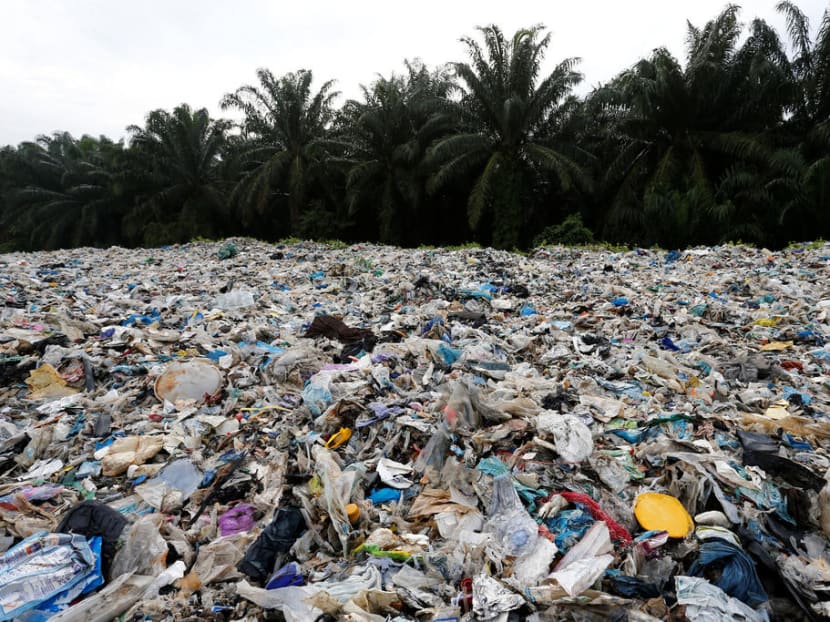An average person could ingest 100,000 plastic particles a year — equal to one credit card a week: Study
SINGAPORE — An average person could be ingesting as many as 1,900 plastic particles a week — more than 100,000 particles a year — from sources such as tap and bottled water, shellfish, beer and salt, a study commissioned by the World Wide Fund for Nature (WWF) has found.

A grey mullet is shown next to microplastic found in Hong Kong waters during a Greenpeace news conference in Hong Kong, China, April 23, 2018.
SINGAPORE — An average person could be ingesting as many as 1,900 plastic particles a week — more than 100,000 particles a year — from sources such as tap and bottled water, shellfish, beer and salt, a study commissioned by the World Wide Fund for Nature (WWF) has found.
This translates to eating about 250 grams of plastic a year. Put another way, it’s like consuming 5 grams of plastic a week — the equivalent of munching through a credit card.
The study, which is the first to estimate and combine insights from over 50 studies globally on the ingestion of plastic by people, was done by researchers at the University of Newcastle in Australia and strategy consulting firm Dalberg Advisors.
Publishing the results of the study on Wednesday (June 12), the WWF added that the findings may be “an underestimate” because the microplastic contamination of staple foods such as milk, rice, wheat, corn, bread, pasta and oils has yet to be studied.
The new research took data from 52 studies, of which 33 looked at plastic consumption through food and beverage.

The report concludes that the average person consumes the equivalent of a credit card's worth of plastic every week. Photo: yourplasticdiet.org
The report found that the “single, largest source of plastic ingestion” is drinking water.
Plastic was found in water — from groundwater, surface water, tap water to bottled water — all over the world.
For example, 98 per cent of tap water samples collected in Lebanon were found to contain plastic fibres. In Indonesia, 76.2 per cent of water samples collected were found with similar fibres.
There were twice as much plastic fibre per 500ml of water observed in American or Indian water, compared with tap water samples in European nations or Indonesia.
The report cited that another key source is shellfish, accounting for as much as 0.5g of plastic ingested a week.
This is because shellfish are eaten whole, including their digestive system, “after a life in plastic polluted seas”, said the report.
Microplastics — which are defined as plastic particles under 5mm in size — “are contaminating the air we breathe, the food we eat, and the water we drink”, said the report.
These particles are created by the disintegration of plastic litter.

Tiny plastic particles that can finish up in food and water come from disintegrating plastic waste,which has increased dramatically in recent years. Photo: Reuters
Primary microplastics are directly released into the environment in the form of small particulates, for example in the form of microbeads in shower gels and cleansing foams, while secondary microplastics are the result of degradation of larger products like plastic bags.
EFFECT ON THE HUMAN BODY
While the impact of microplastics ingestion on human health is not yet fully understood, some types of plastic carry chemicals and additives with potential effects on human health.
A study by Dr Mark Browne, an ecotoxicologist at the University of New South Wales in Sydney, in 2008, found that microplastics had the potential to physically damage organs and leach hazardous chemicals that can compromise the body’s immune function and even stymie growth and reproduction.
Production process residues, additives, dyes and pigments found in plastics have also been shown to have an influence on sexual function, fertility and increased occurrence of mutations and cancers.
In addition, studies have shown that beyond a certain exposure level, inhalation of plastic fibres could result in mild inflammation of the respiratory tract.
Studies are currently being done to better understand the effects of plastic on human health. The World Health Organisation is currently undertaking a review of the health impact of microplastics.
INHALING PLASTICS?
While humans inhale a negligible proportion of microplastics, the study warned that it could vary heavily depending on the environment.
Researchers looked at 16 papers focusing on outdoor and indoor air quality and the results show that indoor air is more heavily plastic polluted than the outdoors.
This comes from the limited air circulation indoors, and the fact that synthetic textiles and household dust are among the most important sources of airborne microplastics.
WHAT NEXT?
Following the release of the findings, the WWF called on governments to “wake up” to the plastic crisis.
It called on governments to set up measurable national targets for plastic reduction and waste management, and legislation to hold businesses accountable for plastics they produce.
“These findings must serve as a wake-up call to governments,” said WWF’s International Director General Marco Lambertini.
“If we don’t want plastic in our bodies, we need to stop the millions of tons of plastic that continue leaking into nature every year. In order to tackle the plastic crisis, we need urgent action at the government, business and consumer levels, and a global treaty with global targets to address plastic pollution,” he said.









